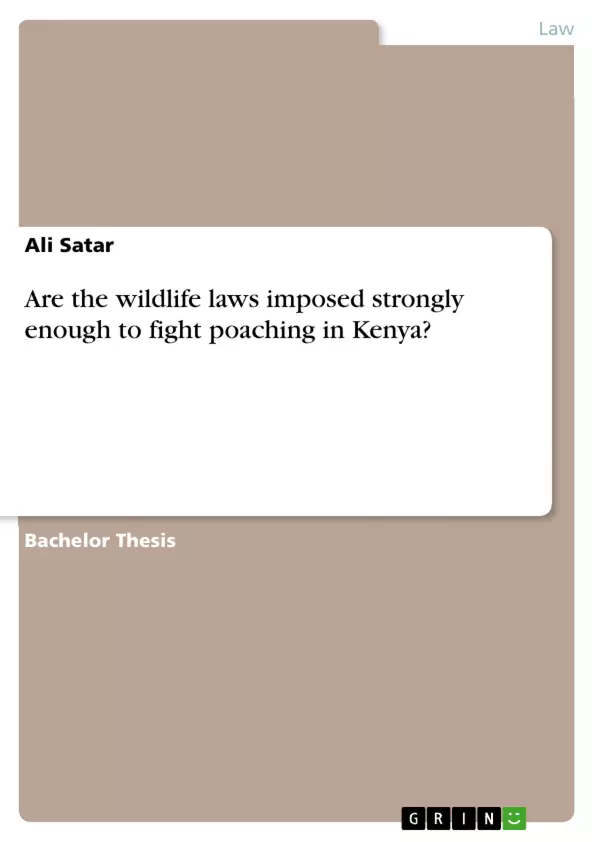Kenya has set up a far-reaching administrative system that criminalizes wildlife poaching. Punishments for infringement of the substantive laws and required legal techniques comprise of fines, imprisonment and relinquishment of tools used to perpetuate a wrongdoing. While certain parts of implementing the substantive laws are shared over a few government foundations, it is the Kenya Wildlife Service (KWS), an organization with full prosecutorial powers that bears the essential duty regarding wildlife. The issue here arises on whether or not the new laws imposed are strong enough to fight poaching or whether the laws should be repealed or replaced again?
The research will contain specific cases and statutes of the law regarding wildlife in Kenya and if they are strong enough to fight poaching and wildlife trade in Kenya. Further, the research shall converse and contrast the current wildlife act and the previous one to see if the laws amended are of any good, and if so, if they reduce poaching, and by how much. If not, it will be discussed whether any new laws can be proposed to do so.
Kenya recently overhauled of the country’s wildlife regulatory regime. In December 2013 Kenya enacted the Wildlife Conservation and Management Act (WCMA) 2013. The WCMA repealed and replaced the Wildlife (Conservation and Management) Act, 1976. The World Wildlife Fund (WWF) helped coordinate the input of environmental civil society organization views after the Wildlife Conservation and Management Act 2013 was passed. This law was a summit of endeavors spreading over more than 15 years to get a far reaching and comprehensive enactment set up.
Inhaltsverzeichnis (Table of Contents)
- CHAPTER ONE
- INTRODUCTION
- 1.1 Background
- 1.1.1 Overhauled Wildlife Laws & Poaching
- 1.1.2 Penalties
- 1.1.3 Enforcement Authority
- 1.1.4 The New Proposed Bill, The Wildlife Conservation and Management (Amendment) Bill, 2017
- 1.2 Statement of the Problem
- 1.3 Literature Review
- 1.4 THEORETICAL FRAMEWORK
- 1.4.1 Theory of Change
- 1.4.2 Deterrence theory
- 1.4.3 Rational Choice Theory
- 1.4.4 Utilitarian School of Thought on the Death Penalty
- 1.4.5 Kantian Ethics on the Death Penalty
- 1.4.6 Alternative Forms of Control Theory
- 1.5 Justification of the study
- 1.6 Research Hypothesis
- 1.7 Research Objectives
- 1.8 Research Questions
- 1.9 Research Methodology
- 1.10 Chapter Breakdown
- CHAPTER TWO
- POACHING: CAUSES & REASONS AND WILDLIFE STATISTICS OVER THE YEARS
- 2.1 Causes & Reasons for Poaching
- 2.1.1 Poverty, Lack of Jobs or Job Opportunities
- 2.1.2 Corruption & Weak Governance
- 2.1.3 Human Wildlife Conflict
- 2.1.4 Bush meat
- 2.2 Wildlife Poaching Statistics Over the Years
- 2.2.1 Rhinos
- 2.2.2 Elephants
- 2.3 Poaching Effects & The Importance of Wildlife Conservation
- 2.3.1 Effects on Local Communities
- 2.3.2 Effects on Animals
- 2.3.3 Effects on the Ecosystem
- 2.3.4 For Agriculture & Farming
- 2.3.5 For a Healthy & Clean Environment
- CHAPTER THREE
- RESEARCH METHODOLOGY, FINDINGS & DISCUSSIONS
- 3.1 Introduction
- 3.2 Measurement Instruments
- 3.3 Reason for Choosing Methodology
- 3.4 Data Results & Findings
- 3.5 Data Analysis
- CHAPTER FOUR
- OVERVIEW OF THE WILDLIFE CONSERVATION AND MANAGEMENT (AMENDMENT) BILL, 2017 TO THE OLD 2013 WCMA ACT.
- 4.1 Introduction
- 4.2 Are the laws imposed strong enough to fight or eradicate poaching in Kenya?
- 4.2.1 Section 92. Offences relating to endangered and threatened species -
- 4.2.2 Section 95. Offences relating to trophies and trophy dealing
- 4.2.3 Section 97. Offenses relating to subsistence hunting
- 4.2.4 Section 98. Offences relating to hunting for bush-meat trade
- 4.2.5 Section 99. Import and export of wildlife species
- 4.2.6 Section 101. Offenses relating to failure comply with a lawful order
Zielsetzung und Themenschwerpunkte (Objectives and Key Themes)
The primary objective of this research paper is to analyze the effectiveness of Kenya's wildlife laws in combating poaching, specifically focusing on the Wildlife (Conservation and Management) Act, 2013 and the proposed amendments of 2017. The paper explores whether these laws are sufficiently robust to deter and punish poachers, ultimately protecting Kenya's endangered wildlife populations.
- The effectiveness of existing wildlife laws in Kenya.
- The impact of poaching on Kenya's wildlife populations, ecosystems, and local communities.
- The role of poverty, corruption, and human-wildlife conflict in driving poaching.
- The implications of the proposed amendments to the Wildlife Conservation and Management (Amendment) Bill, 2017.
- Recommendations for strengthening Kenya's wildlife conservation efforts.
Zusammenfassung der Kapitel (Chapter Summaries)
Chapter One provides an introduction to the research, outlining the background of wildlife conservation in Kenya, including the evolution of wildlife laws and the challenges posed by poaching. It also establishes the research problem, literature review, theoretical framework, and research methodology. Chapter Two delves into the causes and reasons behind poaching in Kenya, examining factors such as poverty, corruption, human-wildlife conflict, and the demand for bush meat. It also presents a historical analysis of wildlife poaching statistics, focusing on the impact on rhinoceros and elephant populations. Chapter Three presents the research methodology, including data collection methods and analysis techniques. Chapter Four explores the proposed Wildlife Conservation and Management (Amendment) Bill, 2017, analyzing its provisions and comparing them to the existing 2013 WCMA Act.
Schlüsselwörter (Keywords)
This research explores the crucial topics of wildlife conservation, poaching, endangered species, Kenyan wildlife laws, the Wildlife (Conservation and Management) Act, 2013, the Wildlife Conservation and Management (Amendment) Bill, 2017, poverty, corruption, human-wildlife conflict, deterrence theory, and rational choice theory.
- Quote paper
- Ali Satar (Author), 2019, Are the wildlife laws imposed strongly enough to fight poaching in Kenya?, Munich, GRIN Verlag, https://www.grin.com/document/490966



